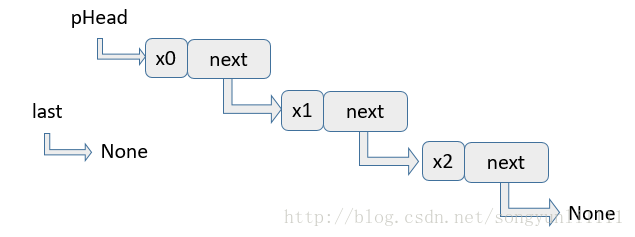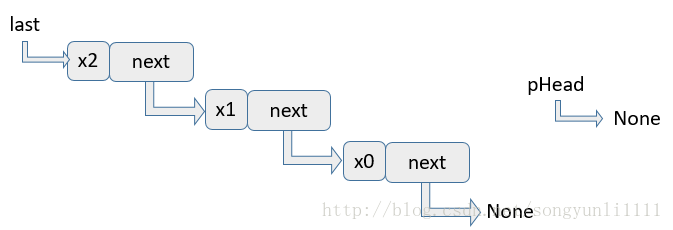一。输入一个链表,输出反转后的链表。
非递归实现:
# -*- coding:utf-8 -*- # class ListNode: # def __init__(self, x): # self.val = x # self.next = None class Solution: # 返回ListNode def ReverseList(self, pHead): # write code here if pHead is None: return pHead last = None #指向上一个节点 while pHead: # 先用tmp保存pHead的下一个节点的信息, # 保证单链表不会因为失去pHead节点的next而就此断裂 tmp = pHead.next # 保存完next,就可以让pHead的next指向last了 pHead.next = last # 让last,pHead依次向后移动一个节点,继续下一次的指针反转 last = pHead pHead = tmp return last
上面程序中的while循环是主要部分,主体部分代码简单,但不是很好理解,下面用图示方法,以三个链表节点为例来展示其反转过程。
1. 初始链表状态
需要定义一个变量last指向pHead的上一个节点

2. 一次迭代之后
x0先暂时被从链表中脱离出来,由last指向,作为反转的新链,x0反转之后会是最后一个节点,因此next指向None,pHead则指向原链的下一个节点x1。

3. 两次迭代之后
x1被脱离出来加入反转的新链,并插入x0之前,pHead再后移。

4. 三次迭代之后
反转完成,pHead指向None即结束循环,返回last即为新链表的头结点。

递归实现:
# -*- coding:utf-8 -*- # class ListNode: # def __init__(self, x): # self.val = x # self.next = None class Solution: # 返回ListNode def ReverseList(self, pHead): # write code here if not pHead or not pHead.next: return pHead else: newHead = self.ReverseList(pHead.next) pHead.next.next=pHead pHead.next=None return newHead
二。给出一个链表,每 k 个节点一组进行翻转,并返回翻转后的链表。
k 是一个正整数,它的值小于或等于链表的长度。如果节点总数不是 k 的整数倍,那么将最后剩余节点保持原有顺序。
示例 :
给定这个链表:1->2->3->4->5
当 k = 2 时,应当返回: 2->1->4->3->5
当 k = 3 时,应当返回: 3->2->1->4->5
说明 :
你的算法只能使用常数的额外空间。
你不能只是单纯的改变节点内部的值,而是需要实际的进行节点交换。
使用递归的方式:
# Definition for singly-linked list. # class ListNode: # def __init__(self, x): # self.val = x # self.next = None class Solution: def reverseKGroup(self, head, k): """ :type head: ListNode :type k: int :rtype: ListNode """ current = head count = 0 while current and count!=k: current = current.next count += 1 if count == k: current = self.reverseKGroup(current,k) while count > 0: temp = head.next head.next = current current = head head = temp count -= 1 head = current return head
三。链表两两反转(递归实现)
# class ListNode: # def __init__(self, x): # self.val = x # self.next = None class Solution: def swapPairs(self, head: ListNode) -> ListNode: if head == None or head.next == None: return head l1 = head.next head.next = self.swapPairs(head.next.next) l1.next = head return l1
非递归加图解

class Solution: def swapPairs(self, head: ListNode) -> ListNode: thead = ListNode(-1) thead.next = head c = thead while c.next and c.next.next: a, b=c.next, c.next.next c.next, a.next = b, b.next b.next = a c = c.next.next return thead.next